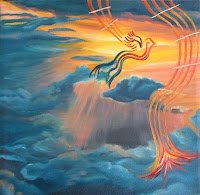For me this chapter on forgetting chemistry was interesting and beautifully written. The discussion on Monet brought about many good points. One I interpreted as saying that an artist should create things that he or she values most. Now this could mean that the artist creates things that end up being accepted by the society or rejected, but art is there to show one's own views of the world and how they see it, not to show how they think others see the world, for this is impossible to truly do. Monet is "just an eye," and he created paintings of images of how he viewed things. Though Monet may have developed a beautiful technique of painting, this does not mean it is the effect everyone is striving or aiming for. Trying to break down the process Monet followed to achieve his results, however lead into another topic of discussion in this chapter, chemistry.
The chapter also discussed artists in comparison to chemists and others with more "knowledgeable" careers. However, I thought it was interesting how they pointed out that really the knowledge is just different between an artist and other more respected careers; where in other fields they have to keep straight many memorized words, artist learn and gain knowledge constantly through experience in the studio, things that are often times indescribable and take many years to learn.
The author made another observation about artists in comparison to chemists. Many times artist do not realize or are unaware of the chemistry behind the materials that they use. For instance, they may not know the processes and ingredients it takes to make the paint they use. Therefore, artist experiment with their materials with open eyes to discover what may happen if they mix two types of medium; Because they don't know the chemistry behind the materials, they don't know how they are going to react so they have to observe all changes carefully. However, chemists who have preconceived expectations often times shut off these keen observational skills that artists use when experimenting. I thought this was a really intriguing idea and liked how the author stated this section.
The Author's words:
"An alchemist who added "agua regia" to "luna" might not have had any idea what could happen.An artist who mixes salt into a lithograph, or beats water into oil paint, is taking the same kind of chance. If there is no way to predict the outcome, or to confidently name the substance, or to describe the process accurately enough so it can be repeated by someone else, then the experimenter has to watch as carefully as possible and take note of every change. THat close observation is sometimes lost today, when we think we know what substances are. In chemistry experiment, the chemist might watch for just one thing: a certain temperature, or a pressure, or the signs of boiling. But artists and alchemists have to keep their eye on everything, because they do not know what to expect. Monet paid strict attention to the motion of his wrist and arm and the varying pressure of his brush against the canvas. He must have spent hours at a time getting his media just right, testing it again and again by dipping a brush into it, or tilting the palette to see how fast it ran. All o it was doe without words, but with intense concentration.














